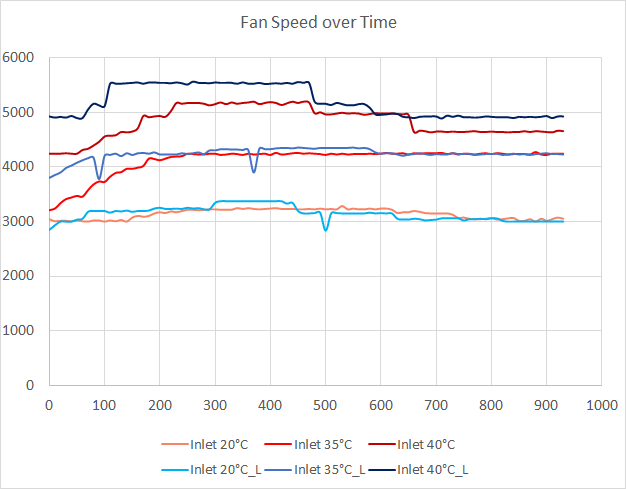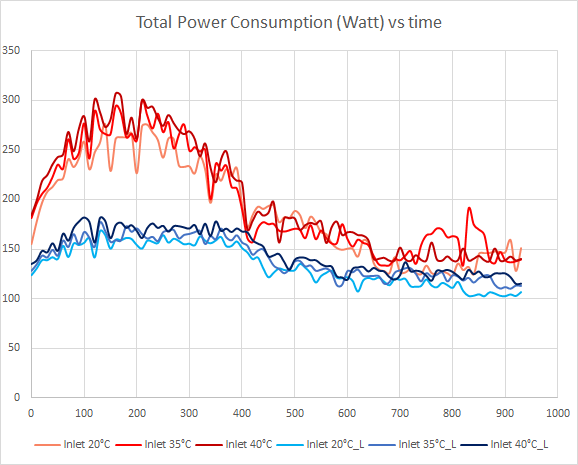Free Cooling: the Server Side of the Story
by Johan De Gelas on February 11, 2014 7:00 AM EST- Posted in
- Cloud Computing
- IT Computing
- Intel
- Xeon
- Ivy Bridge EP
- Supermicro
Fan Speed
How do these higher temperatures affect the fans?
It is clear that the fan speed algorithm takes more than just the CPU temperature and inlet temperature into account. There's definitely an ability to detect when a low power CPU with low tCase is used. As a result the fans are spinning faster with the 2650L than with the 2697 v2. That also means that the server has more headroom for the Xeon E5-2697 v2 than we first assumed based on the CPU temperature results. At higher inlet temperatures, the fans can still go a bit faster if necessary on the 2697, as the maximum fan RPM is 7000.
Power Measurements
The big question of course is how all this affects the power bill. It's no use saving on cooling if your server simply consumes a lot more power due to increased fan speeds (and potentially down time when replacing fans more frequently).
The difference in power consumed is not large between the three inlet temperatures. To make our measurements clear, we standarized on the measurements at 20°C as the baseline and created the following table:
| Xeon E5-2697 v2 | Xeon E5-2650L | |||||
|---|---|---|---|---|---|---|
| CPU load | Inlet 20°C | Inlet 35°C | Inlet 40°C | Inlet 20°C | Inlet 35°C | Inlet 40°C |
| 0-10 | 100% | 105% | 106% | 100% | 106% | 112% |
| 10-20 | 100% | 98% | 103% | 100% | 104% | 108% |
| 20-30 | 100% | 105% | 110% | 100% | 103% | 107% |
| 30-40 | 100% | 102% | 105% | 100% | 102% | 105% |
| 40-50 | 100% | 109% | 108% | 100% | 97% | 109% |
| 50-60 | 100% | 105% | 108% | 100% | 108% | 111% |
| 60-70 | 100% | 106% | 107% | 100% | 104% | 110% |
| 70-80 | 100% | 106% | 104% | 100% | 105% | 109% |
| 80-90 | N/A | N/A | N/A | 100% | 109% | 108% |
| Average | 105% | 107% | 103% | 109% | ||
As the fans work quite a bit harder to keep the 2650L below the low Tcase, they need a lot more power. We notice a 9% increase in power when the inlet temperature doubles. The increase is smaller with the Xeon E5, only 7%.
The most interesting conclusion is that raising the inlet temperature from 20 to 35°C results in almost no increase in power consumption (3-5%) on the server side, while the savings on cooling and ventilation can be substantial, around 40% or more.












48 Comments
View All Comments
iTzSnypah - Tuesday, February 11, 2014 - link
I wonder why nobody has tried geothermal liquid cooling. You could do it 2 ways. Either with a geothermal heat pump set up or cut out the middle man and just use the earth like you would a radiator in a liquid cooling loop. The only problem would be how many wells you would have to drill to cool up to 100MW (I'm thinking 20+ at a depth of at least 50ft).ShieTar - Tuesday, February 11, 2014 - link
Its kind of easier to just use a nearby river than dig for and pump up ground water. That's what power stations and big chemical factories do. For everybody else, air-cooling is just easier and less expensive.iTzSnypah - Tuesday, February 11, 2014 - link
You wouldn't be drilling for water. You drill a well so you can put pipe in it, fill it back up and then pump water through the pipes using the earth's constant temp (~20c) to cool your liquid which is warmer (>~30c).looncraz - Tuesday, February 11, 2014 - link
I experimented with this (mathematically) and found that heat soak is a serious, variable, concern. If the new moisture is coming from the surface, this is not as much of an issue, but if it isn't, you could have a problem in short order. Then there are the corrosion and maintenance issues...The net result is that it is cheaper and easier to just install a few ten thousand gallon coolant holding tanks and keep them cool (but above ambient) and to cool the air in the server room(s). These tanks can be put inside a hill or in the ground for extra installation and a surface radiator system could allow using cold outside air to save energy.
superflex - Wednesday, February 12, 2014 - link
You obviously dont know have a clue about drilling costs.For a 2,000 s.f. home, a geothermal driller needs between 200-300 lineal feet of well bore to cool the house. In unconsolidated material, drilling costs per foot range from $15-$30/foot, depending on the rig. For drilling in rock, up the cost to $45/foot.
For something that uses 80,000x more power than a typical home, what do you think the drilling costs would be?
Go back to heating up Hot Pockets.
chadwilson - Wednesday, February 19, 2014 - link
That last statement was totally unnecessary. Your perfectly valid point was tarnished by your awful attitude.nathanddrews - Tuesday, February 11, 2014 - link
Small scale, but really cool. Use PV to power your pumps...http://www.overclockers.com/forums/showthread.php?...
Sivar - Tuesday, February 11, 2014 - link
Geothermal heat pumps are only moderately more efficient than standard air conditioning and require an enormous amount of area. 20 holes at a depth of 50ft would handle the cooling requirements for a large residential home, but wouldn't even approach the requirements for a data center.One related possibility is to drill to a nearby aquifer and draw cool water, run it through a heat exchanger, then exhaust warm water into the same aquifer. Unfortunately, water overuse has been drained aquifers such that even the pumping costs would be substantial, and the aquifers will eventually be drained to the point that vacuum-based pumps can no longer draw water.
rkcth - Tuesday, February 11, 2014 - link
They are a lot more efficient at heating, but only mildly more efficient at cooling. They also are really storing heat in the ground in the summer and taking it back in the winter, so if you only store heat you can actually have a problem long-term. Your essentially using the ground as a long-term heat storage device since the ground is between 50-60 degrees depending on your area of the country, but use of the geothermal changes that temperature. An air source makes much more sense since you share the air with everyone else and it essentially just blows away.biohazard918 - Tuesday, February 11, 2014 - link
Wells don't use vacuum based pumps most aquifers are much to deep for that instead you stick the pump in the bottom of the well and push the water to the service.